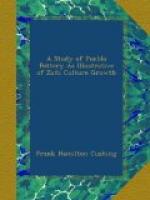This partially explains why the art of water-tight basket-making has here gradually declined since the Spanish conquest, as the ceramic industry has increased with the introduction of the sheep, which furnishes fuel for the burning, and the horse, before unknown, has facilitated transportation, whereby trade for this class of basketry with the distant nomadic tribes who still make it is rendered easy. Withal, however, the quality of pottery has not improved, but has deteriorated; as sheep-dung is but an inferior fuel for firing.
EVOLUTION OF FORMS.
[Illustration: FIG. 523.—Food trencher of wicker-work.]
[Illustration: FIG. 524.—Latter inverted, as used in forming bowls]
Bearing these statements in mind, the discussion of the evolution as well as of the distribution of form, and later of the evolution of decoration, in pottery will become easier. By lingering steps there was early developed a method of building up vessels by a process differing in part from the spiral. As the parching-bowl had been evolved from the roasting-tray, so, we may infer, the food-bowl was suggested by the hemispherical food-trencher of wicker-work. (See Fig. 523.) Yet, curiously enough, the inside of the latter seems not at first to have been used in molding the food-bowl, as, it will be remembered, the tray had been in forming the parching-pan. On the contrary, the clay was coiled around and around the outside of the bottom of an inverted basket bowl (see Fig. 524), instead of being pressed evenly into it. As with the cooking pot, so with this; as the coiling progressed it was corrugated, not so much, however from necessity, as from habit. In consequence of the difficulty experienced in removing these bowl-forms from the bottoms of the baskets—which had to be done while they were still plastic, to keep them from cracking—they were made very shallow. Hence the specimens found among the older ruins and graves are not only corrugated outside, but are also very wide in proportion to their height. (See Fig. 525.) As time went on it was found that bowls might be made deeper, and yet readily be taken off from the basket bottoms, if slightly moistened outside and pressed evenly all around, or, better still, scraped; for, being plastic, this proceeding caused them to grow thinner, consequently larger, thereby to loosen from the basket over which they had been molded. As a result of this scraping, however, the corrugated surface was destroyed, nor could it easily be restored. Therefore bowls when made deep were, as a rule, smooth on the outside as well as on the interior surface. When by a perfectly natural sequence of events—as will be shown further on—ornamentation by painting came to be applied first to the plain interiors of the bowls, the smooth outer surface was found preferable to the corrugated surface, not only because it took paint more readily, but also because the bowl, when




